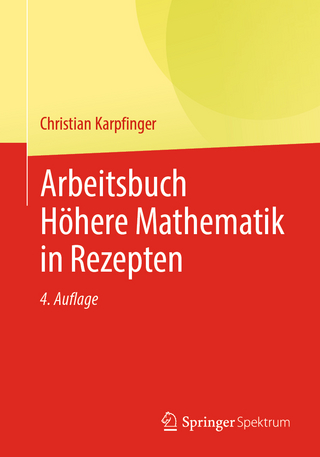
Algebraic Varieties
Springer Berlin (Verlag)
978-3-642-52763-0 (ISBN)
I. A survey of the foundations.- 1. Algebraic varieties.- 2. Absolute and relative varieties.- 3. The local rings.- 4. Algebraic product.- 5. Normal varieties.- 6. Birational transformations.- 7. Simple points.- 8. The intersection multiplicity.- 9. The calculus of cycles.- II. The resolution of singularities.- 1. The local uniformisation theorem.- 2. Monoidal transformations.- 3. Zariski's proof for threefolds.- III. Linear systems.- 1. Divisors.- 2. The definition of linear system.- 3. Linear equivalence.- 4. Complete systems.- 5. The multiples of a linear system.- 6. Ample linear systems.- 7. Bertini's theorems.- IV. The geometric genus.- 1. The adjoint forms.- 2. The canonical system.- 3. The canonical system as a birational invariant.- 4. The arithmetic definition of the canonical system.- 5. Relations between canonical and adjoint systems.- V. The arithmetic genus.- 1. The definition.- 2. The modular property of the arithmetic genus.- 3. The definition of the virtual arithmetic genus of a cycle.- 4. The birational invariance of the arithmetic virtual genus.- 5. The absolute invariance of pa(V) (r ? 3).- 6. The virtual characters of a cycle.- 7. Virtual and effective dimensions.- 8. A second definition of the arithmetic genus.- 9. The virtual characters of K.- VI. Algebraic and rational equivalence.- 1. The associated variety.- 2. Specialisation of a cycle and algebraic systems.- 3. Algebraic correspondences.- 4. The degeneration principle of Enriques-Zariski.- 5. Fundamental and exceptional varieties.- 6. A property of Chow varieties.- 7. Algebraic equivalence.- 8. Rational equivalence.- 9. The intersection-product for equivalence classes.- 10. A theorem of Severi and its consequences.- VII. The Abelian varieties from the algebraic viewpoint, and relatedquestions.- 1. Jacobi variety.- 2. The base for the group of algebraic equivalence for divisors.- 3. The first Picard variety.- 4. The total maximal algebraic families.- 5. A property of the arithmetic genus.- 6. Non-special total families.- 7. The first Picard variety according to Matsusaka.- 8. The second Picard variety and the superficial irregularity.- VIII. Theory and applications of the canonical systems.- 1. Introduction.- 2. A new definition of the canonical divisors.- 3. Todd's canonical systems.- 4. Introduction to Segre's theory.- 5. The covariant sequence.- 6. The algebra of covariant sequences.- 7. The canonical sequence.- 8. Some applications.- 9. The behaviour of the canonical systems under birational transformations.- 10. Irregular intersection problems.- 11. Miscellaneous results.- IX. The algebraic varieties as complex-analytic manifolds.- 1. The complex manifolds and Chow's theorem.- 2. Hermìte's and Kähler's metrics.- 3. The currents.- 4. The fundamental existence theorems.- 5. The complex operators.- 6. The Hodge-Eckmann theory.- 7. Hodge's birational invariants.- 8. Miscellaneous results.- 9. Chern's classes as canonical classes.- X. The applications of stack theory to algebraic geometry.- 1. Complex line bundles.- 2. The stack concept.- 3. Cohomology groups over a stack.- 4. A theorem of Dolbeault.- 5. Positive complex line bundles.- 6. The Picard variety in stack theory.- 7. The theorem of Riemann-Roch for adjoint systems.- 8. The arithmetic genera.- 9. The Riemann-Roch theorem.- 10. Miscellaneous results.- XI. The superficial irregularity and continuous systems.- 1. The deficiency of a linear system.- 2. The Poincaré families.- 3. The superficial irregularity.- 4. Characteristic systems of complete continuous systems.- 5.Miscellaneous results.- 1. Treatises, Monographs and Reports.- 2. List of papers.
| Erscheint lt. Verlag | 21.7.2012 |
|---|---|
| Reihe/Serie | Ergebnisse der Mathematik und ihrer Grenzgebiete. 2. Folge |
| Zusatzinfo | XII, 196 p. |
| Verlagsort | Berlin |
| Sprache | englisch |
| Maße | 155 x 235 mm |
| Gewicht | 326 g |
| Themenwelt | Mathematik / Informatik ► Mathematik ► Algebra |
| Schlagworte | abstract algebra • Algebra • Algebraic Geometry • cohomology • Development • Field • Function • Geometry • Knowledge • manifold • Mathematica • Mathematics • Topology • Transformation |
| ISBN-10 | 3-642-52763-9 / 3642527639 |
| ISBN-13 | 978-3-642-52763-0 / 9783642527630 |
| Zustand | Neuware |
| Haben Sie eine Frage zum Produkt? |
aus dem Bereich


